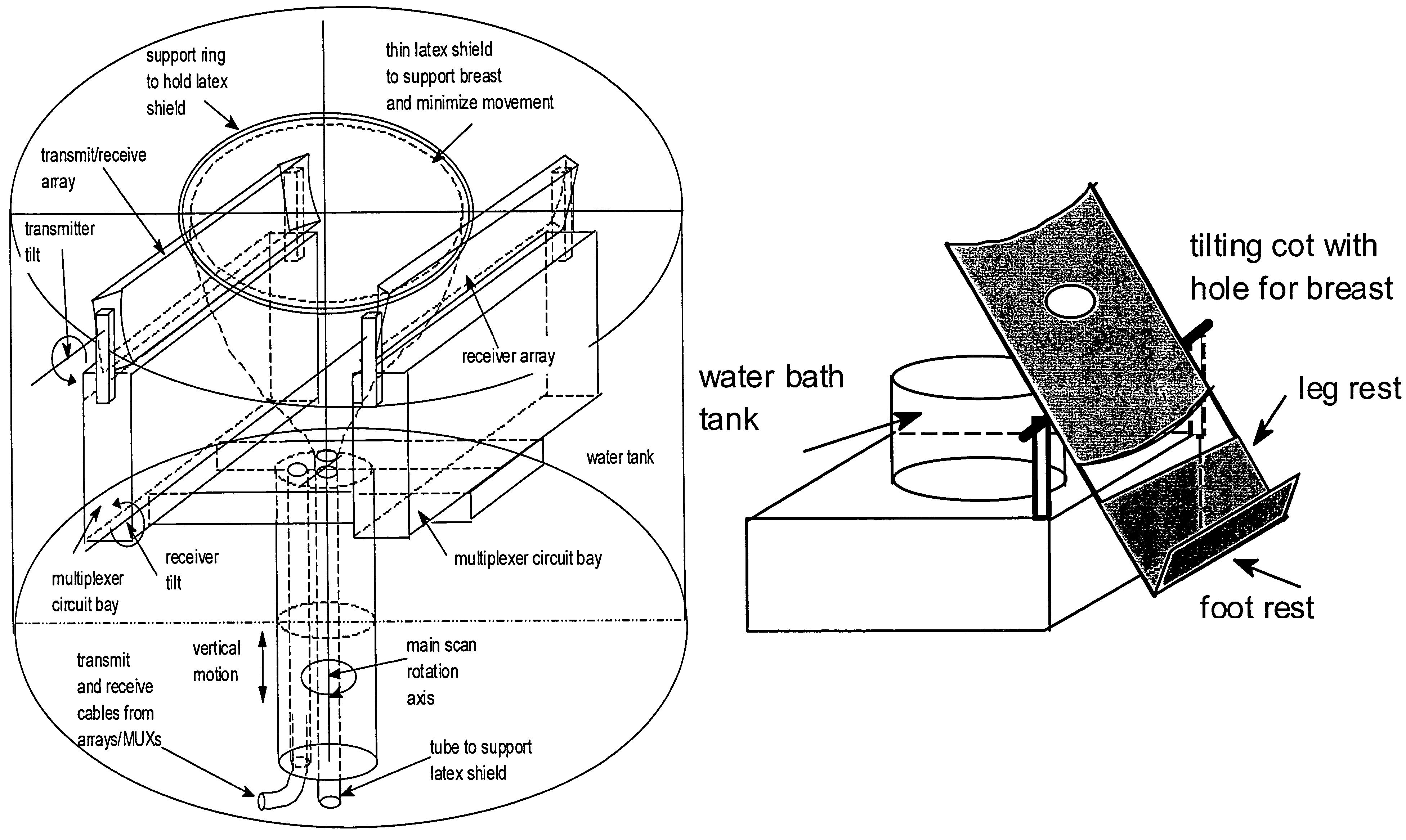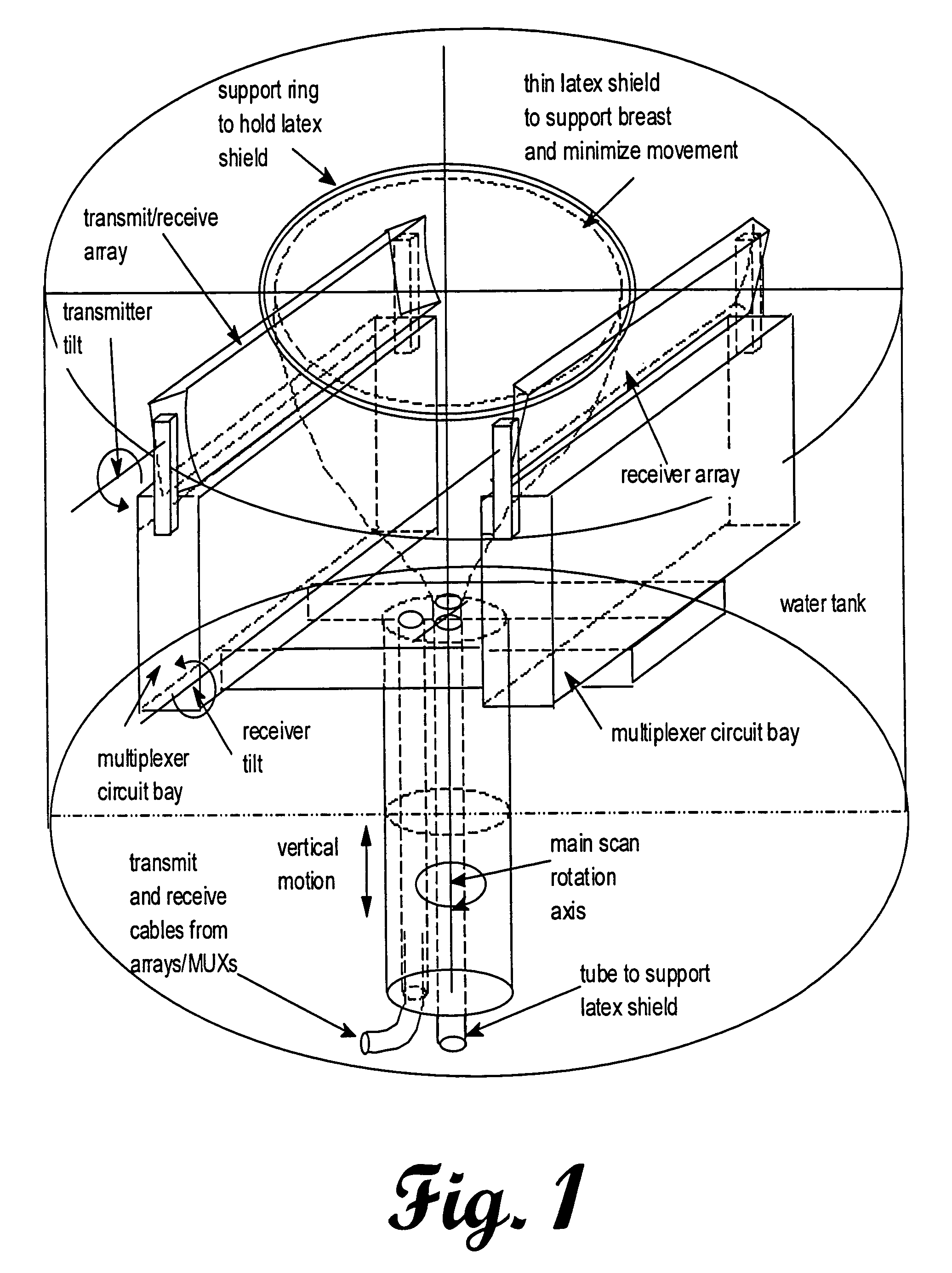Apparatus and method for imaging objects with wavefields
a wavefield and apparatus technology, applied in the field of apparatus and methods for imaging objects with wavefields, can solve the problems of dramatic reduction in computation time and spatial resolution, and achieve the effects of improving the imaging speed of sound, and increasing the speed of the parabolic marching method
- Summary
- Abstract
- Description
- Claims
- Application Information
AI Technical Summary
Benefits of technology
Problems solved by technology
Method used
Image
Examples
examples of embodiment
OF INVENTION
Example 1
[0083]This example is a compression plate ultrasound scanner combining both reflection imaging and transmission inverse scattering imaging. This is not the geometry for the water bath scanner, yet we see that both geometries can produce images of sound speed and attenuation.
[0084]We specify two arrays facing each other, with their faces mutually parallel. Each array can be a 1-D array or a 2-D array of transducer elements. We have constructed compression plate scanner where each array is a 1-D array with 256 elements with ½ element separation at 2 MHz. A drawing of this compression plate configuration is shown in FIGS. 4.a and 4.b. Therein is shown the side view of breast between two compression plates and showing end view of the top and bottom linear array transducers and their translation motions. The two opposing transducers allow transmission data to be collected that includes scattering and diffraction into wide angles and thus improves spatial resolution. ...
example 1
Conclusion for Example 1
[0094]The original parabolic method used λ / 2 pixels. With 2λ pixels, there are 4×4=16 times less pixels, 4 times fewer views and 4 times the inner loop speed, for a factor of 44=256. Changing integral equations from λ / 4 to 2λ pixels, the speed up is 8×8 less pixels and 8 time fewer views (the inner loop does not change significantly) for a factor of 83=512. But the old λ / 2 parabolic is 500 time faster than the ¼ integral equation algorithm; the new parabolic wins. At 5 MHz the 2λ pixel spatial resolution is 0.6 mm. With the new parabolic method two options still exist: (1) use λ / 2 or λ pixels and run the imaging program over night for those slices that are wanted at 0.3 mm spatial resolution; or (2) increase computing power. By Moore's law, computing speed increases 2.5 times per 2 years, so in about 12 years 0.3 mm resolution will be standard.
Example 2
[0095]Inverse scattering images from real lab data from two ¼ inch, 5 Hz Panametrics™ video scan transducers...
example 2
Conclusion for Example 2
[0099]The new fast algorithm has been tested in adverse conditions with poor data from the laboratory (real data!) and performs better than the “gold standard” time of flight CT algorithm. Its predicted performance should be about 10 times better when using data that is designed to meet it's computational and interface requirements. This will be verified in the next two examples.
Example 3
[0100]Inverse scattering images from simulated data from ¼ inch Pamametrics video scan transducers using parabolic wave equation.
[0101]For this computer simulation example we use the following parameters: Frequency=5 MHz. Number of frequencies=1. Pixel dimension=21 Image size 100 by 100 pixels=2.36 by 2.36 inches. Element aperture=0.236 inches. 90 element translation positions for 90 view angles. Speed of sound values (m / s): cwater=1500, cskin=1505, cfat=1490, cparenchyma=1505, ctumor=1510. The image size can easily be doubled or beyond for real data. The results of this simu...
PUM
| Property | Measurement | Unit |
|---|---|---|
| frequencies | aaaaa | aaaaa |
| frequency | aaaaa | aaaaa |
| collection time | aaaaa | aaaaa |
Abstract
Description
Claims
Application Information
 Login to View More
Login to View More - R&D
- Intellectual Property
- Life Sciences
- Materials
- Tech Scout
- Unparalleled Data Quality
- Higher Quality Content
- 60% Fewer Hallucinations
Browse by: Latest US Patents, China's latest patents, Technical Efficacy Thesaurus, Application Domain, Technology Topic, Popular Technical Reports.
© 2025 PatSnap. All rights reserved.Legal|Privacy policy|Modern Slavery Act Transparency Statement|Sitemap|About US| Contact US: help@patsnap.com



